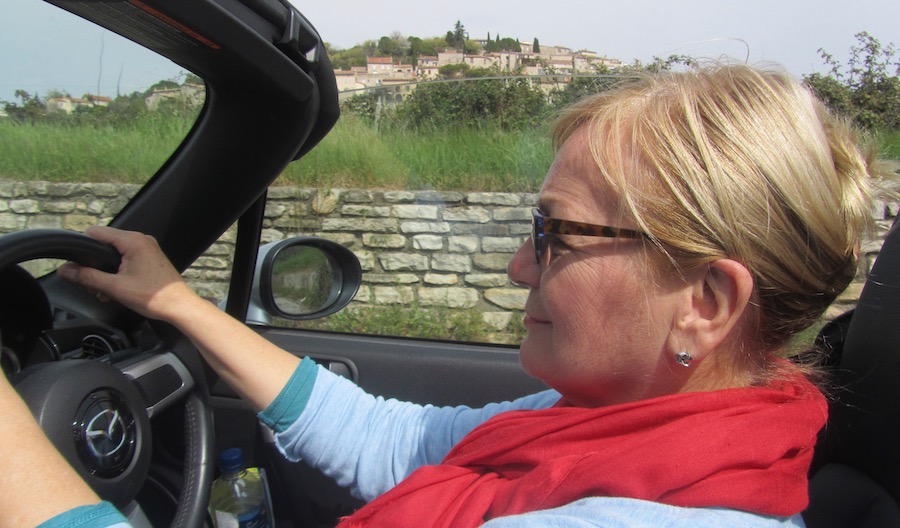CARS

COLIN SIMPSON
What We've Learned in Our Years Abroad
WHEREVER you grow up there are some things you take for granted and never think about. Then you move abroad, and you realise the picture is very different elsewhere.
Take cars, for example. At the end of last year there were 38.2 million licensed vehicles in Great Britain, up 1.2 percent from a year before, according to the Department of Transport. Yes, we British love our cars. When Sue and I were growing up our dads (though not our mums) always had cars, and the same was true for almost everyone we knew.
In due course, after the daunting rite of passage that is getting through the driving test, we joined the army of motorists. My first car was a rusting Toyota Carina that cost £500, while Sue fell in love with Morris Minors.
All the time we lived in the UK we had cars, as did all our friends. Since moving abroad we’ve lived in places where, again, everyone we met had wheels. And we’ve lived in places where no one we knew, apart from the occasional millionaire acquaintance, had a car (in their case, more than one).
So here’s what we’ve learned, car and transport-wise, in the years since we became expats:
Dubai: Land Cruisers, Supercars and Cheap Fuel

YOUR average Western expat in Dubai will not only have a car, he’ll have one that’s a lot better than anything he could afford at home. It’s one of the attractions of moving to somewhere with low taxes and cheap fuel. It was even better when we were there, before 5 percent VAT was slapped on vehicles sold in the United Arab Emirates (of which Dubai is part) in January last year.
Still, compared with other places that’s not too bad. Tax on cars sold in Hong Kong, where we live now, ranges from 40 percent of the value of the vehicle up to 115 percent for top-end models. The truth is that in Dubai, you really need a car. (I am of course talking about comfortably-off Western expats. I’m all too aware of the predicament of the other expats, the manual labourers from Southeast Asia who built all those fabulous skyscrapers and who struggle to get enough food.)
Temperatures in the summer really do reach 50C, and if you have to stand in the street waiting for a taxi for even a few minutes you start to feel uncomfortable.
Instead, you get the lift down to the basement car park below your apartment block in Dubai Marina or somewhere along Sheikh Zayed Road. You get into your Jeep or your fancy Toyota (Toyotas are popular in this part of the world), crank up the aircon and head off. Upon reaching your destination, you park in another underground car park and get the lift up to wherever you’re going. You never have to leave the air-conditioned cocoon.
Before all this, though, you have to steel yourself actually to get behind the wheel. When we visited Dubai on holiday before we moved out I couldn’t imagine driving there. The traffic was too fast on those dead straight 10-lane highways, the driving too reckless and anarchic, the concern for safety too non-existent. When you move there, though, you gradually realise needs must and come round to the idea. And, after a while, you sort of get used to the speed, the tailgating, the wild sweeps across three or four lanes by drivers who glance up from their phone and realise they’re almost level with their exit.



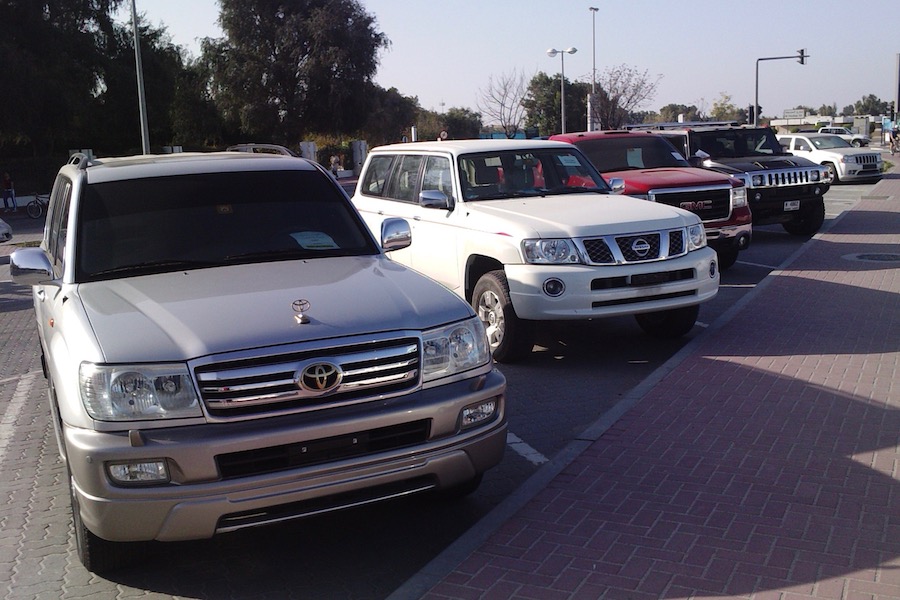


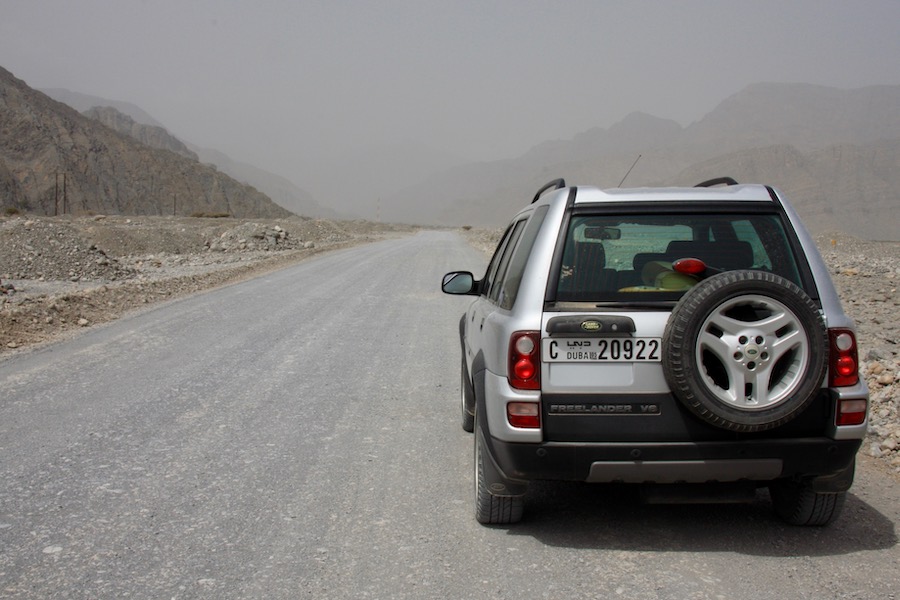


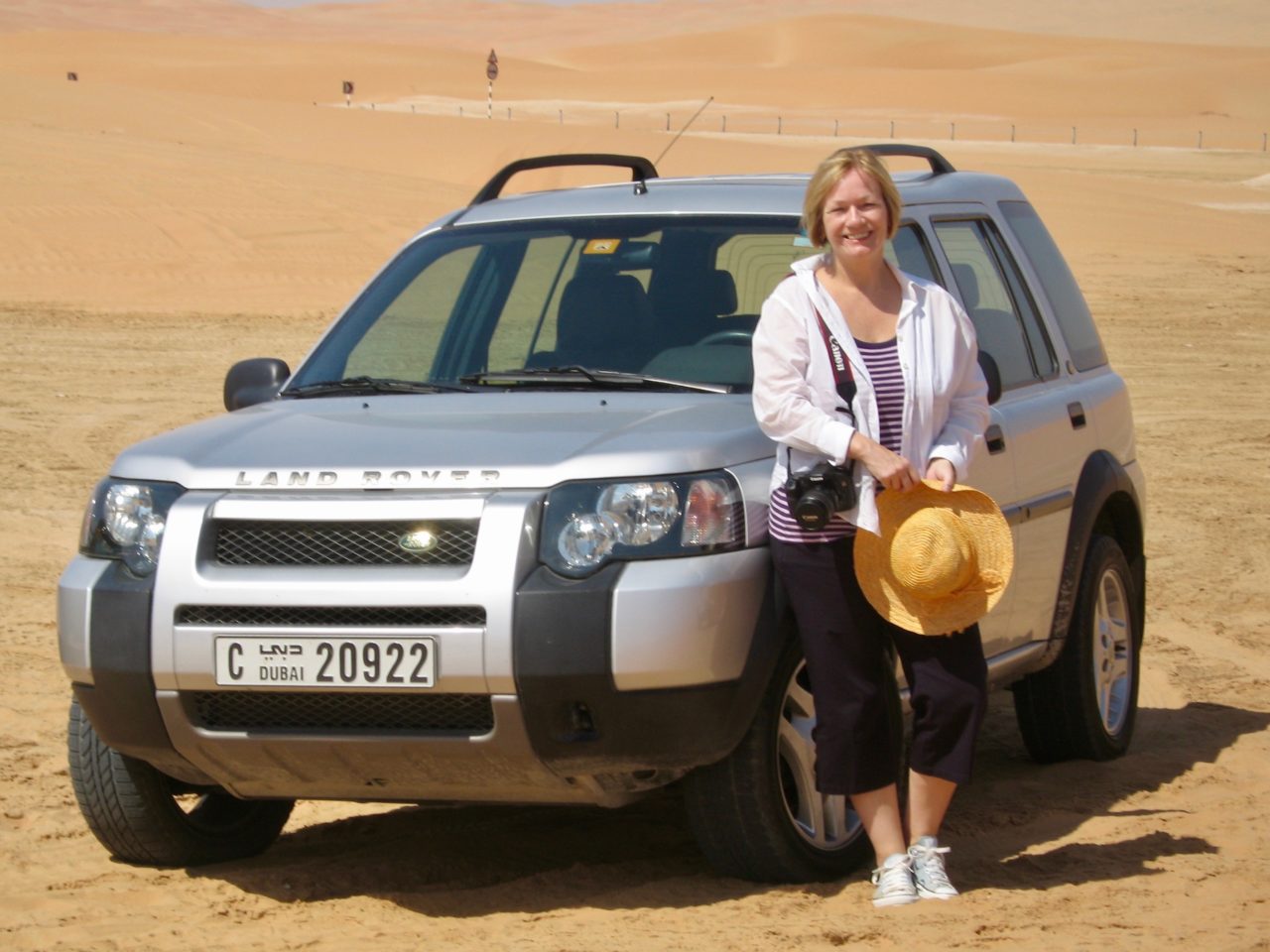

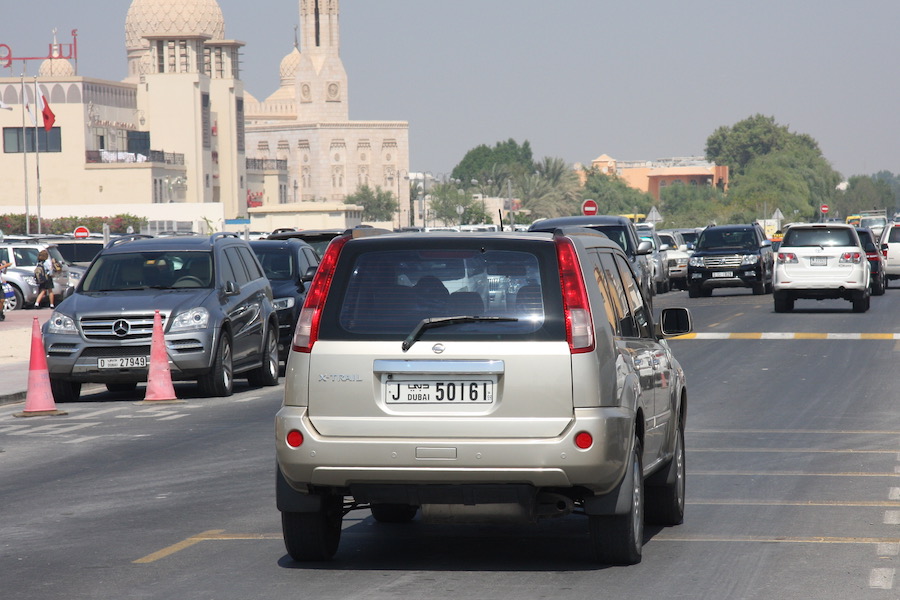
A colleague who was taking driving lessons in Dubai told me his instructor said that if you could see the rear bumper of the car ahead you were a safe distance away from it, which probably explains a lot.
For some, the ones who buy Jeeps and other four-by-fours, their cars provide a way of letting off steam. At the weekend they head out of town to the desert and tear up and down sand dunes, or camp out on the sands.
Famously, some expats who were side-swiped by the 2008 financial crisis, dumped their cars as they headed for the airport. They were abandoned not only at the airport but at locations across the city. We used to see them parked near Al Wasl Park when we used the running track there.
The locals, the Emiratis, love their cars too, but on an entirely different level. They promenade noisily along Jumeirah Beach Road in Ferraris and Lamborghinis in striking colours, and in other cars so rare and expensive and exotic that few can name them. And Sue never got used to her female Emirati colleagues favouring the stonking great Humvee as their car of choice.
The love of cars extends to Dubai’s ruler, Sheikh Mohammed. He displays the number plate “1” on his cars, and when this was seen attached to a Bugatti parked outside the Mall of the Emirates it caused a social media sensation. His trademark vehicle is a Mercedes-Benz G-Wagen, and locals who like to show support for him drive them as well. Another way of showing support is to splatter pictures of ruling family members over your car.
Our wheels were a lot less impressive, though we liked them. I bought a new black Toyota (yes) Camry, a largish – by British standards – saloon, then replaced it with a nice white Ford Escape. Sue achieved a lifetime ambition by acquiring a Land-Rover, and later drove a robust silver Nissan X-Trail.
Saudi Arabia: 13-Year-Olds in Rustbuckets
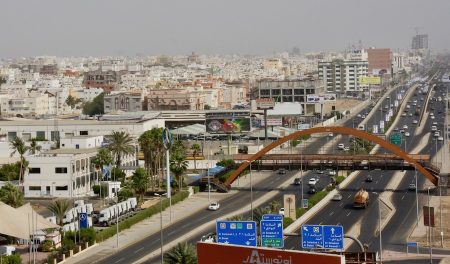
YOU’RE driving along a wide city road when suddenly an ancient wreck of a saloon careers out of a side-street into the fast-moving traffic. The car looks as if it should have been scrapped years ago, but the really odd thing is that it doesn’t seem to have a driver. You take a second look, and realise it’s being steered by a boy of 12 or 13, his arms reaching up to the wheel.
You head on a bit, and find yourself navigating a roundabout. You have to be careful, though, as drivers in this city don’t slow down at all when they sweep onto a roundabout. Instead, those already there edge their way tentatively around the junction, hoping they can avoid colliding with the stream of new arrivals.
Perhaps you get a bit fed up with all this, and decide to walk instead. But then you could be marooned on one side of a vast road for five or 10 minutes; pedestrian crossings aren’t really a thing here, and drivers never slow to let you cross.
Ahah! I’ll get around by taxi, you think. But then you might find, as we did, that you’re being driven at speed the wrong way up the exit road to join a motorway after the driver missed the entry road and performed a screeching U-turn. You can just make out the tops of the lorries as they rumble along the highway, and pray that one isn’t about to turn off.
Welcome to the wild west world of driving in Saudi Arabia. The driving there is so reckless, the speeds so extreme, the chances of a crash seemingly so high that you just have to laugh. We were in Jeddah before women were allowed to drive, and I’m sure the absence of a calming female influence on the roads contributed to the testosterone-driven mayhem.
Some, though not all, of the Western expats we knew had cars. If we’d stayed longer we’d have bought one too – I had my eye on a white Toyota (of course) Prada. In the meantime, I hired cars when we wanted to head into Jeddah from the campus where we worked nearly 100 kilometres out in the desert, or Sue had to sit in a waiting room until a campus-employed driver became free to drive her to a meeting.
All the Saudis we worked with owned cars. This is partly because public transport is pretty non-existent in the kingdom. There are grandiose plans to set up extensive transport networks across the country and in cities, but since the railways haven’t improved all that much since the days of Lawrence of Arabia I wouldn’t hold out much hope.
When I looked up the “Future of Transport” section of the government’s website I got a 404 error message that said “The page you are looking for does not exist”.
Gap Year: Topless in the South of France
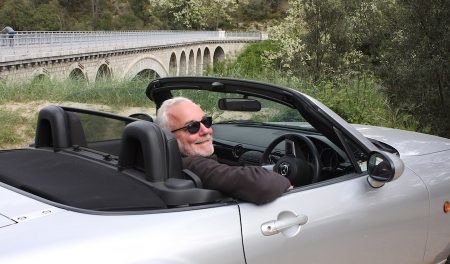
WHEN we left the Middle East we took a year off to travel (the subject of an upcoming Expat Life post). For our ten-week road trip around California we had, for the first half, a boring maroon Nissan Altima, and for the second a splendid black Dodge Charger. The Altima is a solid, sturdy car, but when you’re driving along Route 66 in one there’s just something missing, that’s all.
I really loved the Dodge and took to photographing it at famous sites, placing it so that it obstructed the view of, say, Bixby Bridge at Big Sur. We had hoped to hire a convertible, ideally a Mustang, but found these were difficult to come by as not many rental companies have them, contrary to popular belief.
We then had three months in the Seychelles, and hired a white Hyundai i10. A period of adjustment was required, as some of the roads there are narrow and twisty, and in heavy rain chunks of roads collapse. A particular annoyance was the lack of parking places next to the beautiful beaches (I don’t expect much sympathy for this).
After this, we had a three-month spell in the South of France followed by a few months at our house in the UK before moving to Beijing to resume work. During this period we used my silver Mazda MX-5, which I keep in storage in the UK. It was great driving with the top down along a track through a vineyard to a bakery in the next hamlet to pick up croissants for breakfast.
Though the MX-5 is another car I love, it’s also the biggest mistake I made when I became an expat. I had bought it a couple of years before we left, and stood to make a big loss if I’d sold it then.
So I decided to hang on to it, and have since watched it depreciate sharply as I paid storage fees year after year. I should, of course, have sold it. But when you move abroad you don’t really know how things are going to work out. We thought we might return home after six months, and envisaged staying away for maybe two years at the most. Nearly 13 years on, we’re still expats, and 13 years older so hoping we can still get in and out of my low-to-the-ground sports car!
So that would be my advice: If you make the move abroad, assume you’re going to be away for a long time, and adjust your mindset accordingly. That way you won’t make the same costly mistake as me.
Beijing: Mini-Motorbikes, Packed Buses

NONE of the expats we knew in Beijing had a car, though many had bicycles (it’s a very flat city) or small motorbikes. The newspaper where we worked provided accommodation for expat staff, officially classed as “foreign experts”. There was a high turnover, and as some headed back home they would leave their bikes piled up on the rack outside the apartment block, where they would gather dirt and rust until they were periodically removed by the management. Many of our Chinese colleagues had cars.
Beijing has an ever-expanding subway network and plenty of buses, but public transport is not particularly well planned or easy to use. The subway stations are a long way apart, so when you reach the one nearest to your destination the chances are you’ll still have to walk some distance or catch a bus. But often you’ll get up to the street and find there is no bus stop nearby. The fact that Google Maps is blocked in China and local navigation apps are in Chinese adds to the difficulty many expats find when trying to get around.
Buses on popular routes can be slow moving, and Beijing’s heavy traffic means journeys can take a long time. Sue found them a friendly way of getting around, and learned that just when she thought her bus was full, at least 100 more passengers could pack onto it.
Taxis can be problematic. For instance, you can be told to get out in the middle of a busy, six-lane road because the driver refuses to do a U-turn and drop you off safely outside your destination at the opposite side. Most people use ride-hailing apps, but if you don’t speak Chinese then you’re pretty stuck.
The best solution if you’re heading off to the Great Wall or other tourist attractions is to use a reliable car-and-driver service.
Hong Kong: No Parking, Great Public Transport
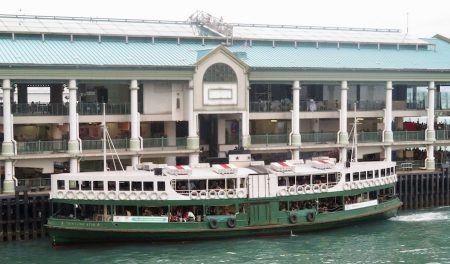
IN CONTRAST to Beijing, Hong Kong has fabulous, cheap and reliable public transport, so you don’t need a car. There’s the MTR subway system, loads of buses, characterful double-decker trams, plenty of low-priced taxis, and ferry services to the outlying islands.
We hired a car once for a weekend to explore the New Territories, which let us get around a lot of places in one go, but have never done it again. Unlike many places, Hong Kong is not built for mass car ownership. For one thing, there’s a shortage of parking – a couple of times we went to visit somewhere that weekend, but had to drive on because we couldn’t get parked.
Most of the expats we know in Hong Kong have never driven here, though as in Beijing one or two have small motorcycles. For most, even well-paid finance sector types, car ownership is just not worth the sky-high cost and hassle.
So there you have it. As with all things expat, expect a wide range of car and transport experiences as you move to different countries.
September 2019
Don't Forget Your Driving Licence
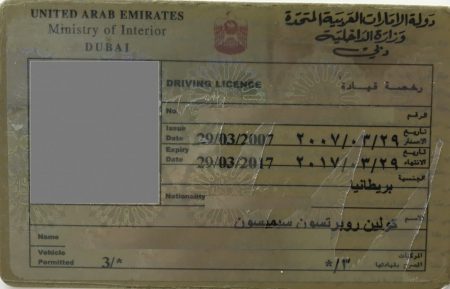
IF you’re moving abroad and plan to drive one of the many things you’ll have to sort out is, of course, your driving licence. It’s important to find out what the rules are to avoid problems if the police pull you over. Regulations and practices vary from country to country, and in, for example, China they vary across the different provinces and are subject to change.
In some cases you can drive using a licence issued by your home country for a period of time. In France, for example, you can do this for a year, while in the Seychelles the limit is three months. Generally speaking you should obtain a driving licence in the country where you’re a resident. In many cases expats from some countries will be able to swap their home-country licence for a local one. Those from other countries will probably have to take a test.
We found obtaining a licence in the United Arab Emirates and Hong Kong pretty straightforward. In Saudi Arabia the process was complicated and involved visiting offices in different towns in the desert. Colin had help from our employer’s government affairs office – a department that liaises with officials over a range of matters. Without this support, it would probably have been impossible – which it literally was for Sue. As mentioned above, getting a licence in China can be tricky.
For our fellow Brits planning to move to countries in the European Union, life will become a lot more complicated if and when Brexit goes through. The UK’s Transport Department provides updated details of the requirements for different EU countries on the gov.uk website, but be warned, they’re mind-bogglingly complicated.
RELATED
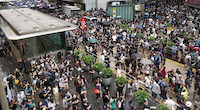 TROUBLED TIMES FOR EXPATS: Moving abroad can seem an idyllic prospect, but what happens when sudden upheavals or the inescapable realities of life intrude? READ MORE
TROUBLED TIMES FOR EXPATS: Moving abroad can seem an idyllic prospect, but what happens when sudden upheavals or the inescapable realities of life intrude? READ MORE
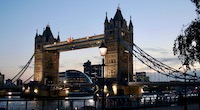 TRIPS HOME: What happens when your home country, the place where you grew up and you know best, turns into somewhere that you go to on holiday? READ MORE
TRIPS HOME: What happens when your home country, the place where you grew up and you know best, turns into somewhere that you go to on holiday? READ MORE
 HOME THOUGHTS: Leaving home to live and work abroad is exciting, but years later you find yourself wondering exactly where is home. READ MORE
HOME THOUGHTS: Leaving home to live and work abroad is exciting, but years later you find yourself wondering exactly where is home. READ MORE
RECOMMENDED
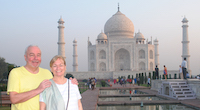 WELCOME TO OUR WORLD! Afaranwide’s home page – this is where you can find out about our latest posts and other highlights. READ MORE
WELCOME TO OUR WORLD! Afaranwide’s home page – this is where you can find out about our latest posts and other highlights. READ MORE
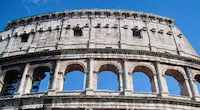 TOP 10 VIRTUAL ATTRACTIONS: Many of the world’s most popular tourists sites are closed because of the coronavirus crisis, but you can still visit them virtually while you’re self-isolating. READ MORE
TOP 10 VIRTUAL ATTRACTIONS: Many of the world’s most popular tourists sites are closed because of the coronavirus crisis, but you can still visit them virtually while you’re self-isolating. READ MORE
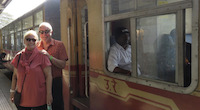 SHIMLA, QUEEN OF THE HILLS: Government officials once retreated to Shimla in the foothills of the Himalayas to escape India’s blazing hot summers. Now tourists make the same journey. READ MORE
SHIMLA, QUEEN OF THE HILLS: Government officials once retreated to Shimla in the foothills of the Himalayas to escape India’s blazing hot summers. Now tourists make the same journey. READ MORE
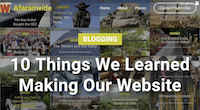 TEN THINGS WE LEARNED: Our up-to-the-minute guide to creating a website, one step at a time. The costs, the mistakes – it’s what we wish we’d known when we started blogging. READ MORE
TEN THINGS WE LEARNED: Our up-to-the-minute guide to creating a website, one step at a time. The costs, the mistakes – it’s what we wish we’d known when we started blogging. READ MORE
 TROUBLED TIMES FOR EXPATS: Moving abroad can seem an idyllic prospect, but what happens when sudden upheavals or the inescapable realities of life intrude? READ MORE
TROUBLED TIMES FOR EXPATS: Moving abroad can seem an idyllic prospect, but what happens when sudden upheavals or the inescapable realities of life intrude? READ MORE
LET'S KEEP IN TOUCH!
CARS

COLIN SIMPSON
What We've Learned in Our Years Abroad
WHEREVER you grow up there are some things you take for granted and never think about. Then you move abroad, and you realise the picture is very different elsewhere.
Take cars, for example. At the end of last year there were 38.2 million licensed vehicles in Great Britain, up 1.2 percent from a year before, according to the Department of Transport. Yes, we British love our cars. When Sue and I were growing up our dads (though not our mums) always had cars, and the same was true for almost everyone we knew.
In due course, after the daunting rite of passage that is getting through the driving test, we joined the army of motorists. My first car was a rusting Toyota Carina that cost £500, while Sue fell in love with Morris Minors.
All the time we lived in the UK we had cars, as did all our friends. Since moving abroad we’ve lived in places where, again, everyone we met had wheels. And we’ve lived in places where no one we knew, apart from the occasional millionaire acquaintance, had a car (in their case, more than one).
So here’s what we’ve learned, car and transport-wise, in the years since we became expats:
Dubai: Land Cruisers, Supercars and Cheap Fuel

YOUR average Western expat in Dubai will not only have a car, he’ll have one that’s a lot better than anything he could afford at home. It’s one of the attractions of moving to somewhere with low taxes and cheap fuel. It was even better when we were there, before 5 percent VAT was slapped on vehicles sold in the United Arab Emirates (of which Dubai is part) in January last year.
Still, compared with other places that’s not too bad. Tax on cars sold in Hong Kong, where we live now, ranges from 40 percent of the value of the vehicle up to 115 percent for top-end models. The truth is that in Dubai, you really need a car. (I am of course talking about comfortably-off Western expats. I’m all too aware of the predicament of the other expats, the manual labourers from Southeast Asia who built all those fabulous skyscrapers and who struggle to get enough food.)
Temperatures in the summer really do reach 50C, and if you have to stand in the street waiting for a taxi for even a few minutes you start to feel uncomfortable.
Instead, you get the lift down to the basement car park below your apartment block in Dubai Marina or somewhere along Sheikh Zayed Road. You get into your Jeep or your fancy Toyota (Toyotas are popular in this part of the world), crank up the aircon and head off. Upon reaching your destination, you park in another underground car park and get the lift up to wherever you’re going. You never have to leave the air-conditioned cocoon.
Before all this, though, you have to steel yourself actually to get behind the wheel. When we visited Dubai on holiday before we moved out I couldn’t imagine driving there. The traffic was too fast on those dead straight 10-lane highways, the driving too reckless and anarchic, the concern for safety too non-existent. When you move there, though, you gradually realise needs must and come round to the idea. And, after a while, you sort of get used to the speed, the tailgating, the wild sweeps across three or four lanes by drivers who glance up from their phone and realise they’re almost level with their exit.









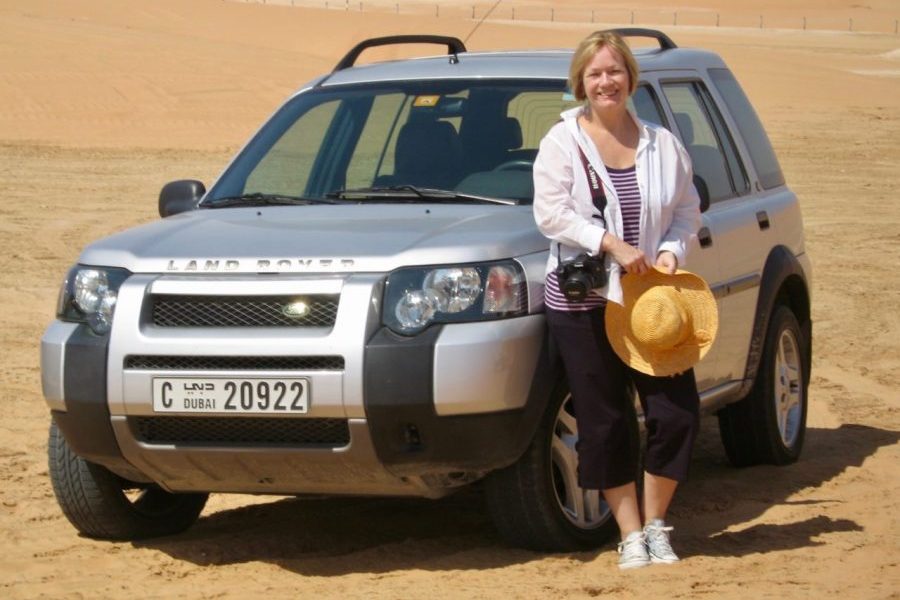


A colleague who was taking driving lessons in Dubai told me his instructor said that if you could see the rear bumper of the car ahead you were a safe distance away from it, which probably explains a lot.
For some, the ones who buy Jeeps and other four-by-fours, their cars provide a way of letting off steam. At the weekend they head out of town to the desert and tear up and down sand dunes, or camp out on the sands.
Famously, some expats who were side-swiped by the 2008 financial crisis, dumped their cars as they headed for the airport. They were abandoned not only at the airport but at locations across the city. We used to see them parked near Al Wasl Park when we used the running track there.
The locals, the Emiratis, love their cars too, but on an entirely different level. They promenade noisily along Jumeirah Beach Road in Ferraris and Lamborghinis in striking colours, and in other cars so rare and expensive and exotic that few can name them. And Sue never got used to her female Emirati colleagues favouring the stonking great Humvee as their car of choice.
The love of cars extends to Dubai’s ruler, Sheikh Mohammed. He displays the number plate “1” on his cars, and when this was seen attached to a Bugatti parked outside the Mall of the Emirates it caused a social media sensation. His trademark vehicle is a Mercedes-Benz G-Wagen, and locals who like to show support for him drive them as well. Another way of showing support is to splatter pictures of ruling family members over your car.
Our wheels were a lot less impressive, though we liked them. I bought a new black Toyota (yes) Camry, a largish – by British standards – saloon, then replaced it with a nice white Ford Escape. Sue achieved a lifetime ambition by acquiring a Land-Rover, and later drove a robust silver Nissan X-Trail.
Saudi Arabia: 13-Year-Olds in Rustbuckets

YOU’RE driving along a wide city road when suddenly an ancient wreck of a saloon careers out of a side-street into the fast-moving traffic. The car looks as if it should have been scrapped years ago, but the really odd thing is that it doesn’t seem to have a driver. You take a second look, and realise it’s being steered by a boy of 12 or 13, his arms reaching up to the wheel.
You head on a bit, and find yourself navigating a roundabout. You have to be careful, though, as drivers in this city don’t slow down at all when they sweep onto a roundabout. Instead, those already there edge their way tentatively around the junction, hoping they can avoid colliding with the stream of new arrivals.
Perhaps you get a bit fed up with all this, and decide to walk instead. But then you could be marooned on one side of a vast road for five or 10 minutes; pedestrian crossings aren’t really a thing here, and drivers never slow to let you cross.
Ahah! I’ll get around by taxi, you think. But then you might find, as we did, that you’re being driven at speed the wrong way up the exit road to join a motorway after the driver missed the entry road and performed a screeching U-turn. You can just make out the tops of the lorries as they rumble along the highway, and pray that one isn’t about to turn off.
Welcome to the wild west world of driving in Saudi Arabia. The driving there is so reckless, the speeds so extreme, the chances of a crash seemingly so high that you just have to laugh. We were in Jeddah before women were allowed to drive, and I’m sure the absence of a calming female influence on the roads contributed to the testosterone-driven mayhem.
Some, though not all, of the Western expats we knew had cars. If we’d stayed longer we’d have bought one too – I had my eye on a white Toyota (of course) Prada. In the meantime, I hired cars when we wanted to head into Jeddah from the campus where we worked nearly 100 kilometres out in the desert, or Sue had to sit in a waiting room until a campus-employed driver became free to drive her to a meeting.
All the Saudis we worked with owned cars. This is partly because public transport is pretty non-existent in the kingdom. There are grandiose plans to set up extensive transport networks across the country and in cities, but since the railways haven’t improved all that much since the days of Lawrence of Arabia I wouldn’t hold out much hope.
When I looked up the “Future of Transport” section of the government’s website I got a 404 error message that said “The page you are looking for does not exist”.
Gap Year: Topless in the South of France

WHEN we left the Middle East we took a year off to travel (the subject of an upcoming Expat Life post). For our ten-week road trip around California we had, for the first half, a boring maroon Nissan Altima, and for the second a splendid black Dodge Charger. The Altima is a solid, sturdy car, but when you’re driving along Route 66 in one there’s just something missing, that’s all.
I really loved the Dodge and took to photographing it at famous sites, placing it so that it obstructed the view of, say, Bixby Bridge at Big Sur. We had hoped to hire a convertible, ideally a Mustang, but found these were difficult to come by as not many rental companies have them, contrary to popular belief.
We then had three months in the Seychelles, and hired a white Hyundai i10. A period of adjustment was required, as some of the roads there are narrow and twisty, and in heavy rain chunks of roads collapse. A particular annoyance was the lack of parking places next to the beautiful beaches (I don’t expect much sympathy for this).
After this, we had a three-month spell in the South of France followed by a few months at our house in the UK before moving to Beijing to resume work. During this period we used my silver Mazda MX-5, which I keep in storage in the UK. It was great driving with the top down along a track through a vineyard to a bakery in the next hamlet to pick up croissants for breakfast.
Though the MX-5 is another car I love, it’s also the biggest mistake I made when I became an expat. I had bought it a couple of years before we left, and stood to make a big loss if I’d sold it then.
So I decided to hang on to it, and have since watched it depreciate sharply as I paid storage fees year after year. I should, of course, have sold it. But when you move abroad you don’t really know how things are going to work out. We thought we might return home after six months, and envisaged staying away for maybe two years at the most. Nearly 13 years on, we’re still expats, and 13 years older so hoping we can still get in and out of my low-to-the-ground sports car!
So that would be my advice: If you make the move abroad, assume you’re going to be away for a long time, and adjust your mindset accordingly. That way you won’t make the same costly mistake as me.
Beijing: Mini-Motorbikes, Packed Buses

NONE of the expats we knew in Beijing had a car, though many had bicycles (it’s a very flat city) or small motorbikes. The newspaper where we worked provided accommodation for expat staff, officially classed as “foreign experts”. There was a high turnover, and as some headed back home they would leave their bikes piled up on the rack outside the apartment block, where they would gather dirt and rust until they were periodically removed by the management. Many of our Chinese colleagues had cars.
Beijing has an ever-expanding subway network and plenty of buses, but public transport is not particularly well planned or easy to use. The subway stations are a long way apart, so when you reach the one nearest to your destination the chances are you’ll still have to walk some distance or catch a bus. But often you’ll get up to the street and find there is no bus stop nearby. The fact that Google Maps is blocked in China and local navigation apps are in Chinese adds to the difficulty many expats find when trying to get around.
Buses on popular routes can be slow moving, and Beijing’s heavy traffic means journeys can take a long time. Sue found them a friendly way of getting around, and learned that just when she thought her bus was full, at least 100 more passengers could pack onto it.
Taxis can be problematic. For instance, you can be told to get out in the middle of a busy, six-lane road because the driver refuses to do a U-turn and drop you off safely outside your destination at the opposite side. Most people use ride-hailing apps, but if you don’t speak Chinese then you’re pretty stuck.
The best solution if you’re heading off to the Great Wall or other tourist attractions is to use a reliable car-and-driver service.
Hong Kong: No Parking, Great Public Transport

IN CONTRAST to Beijing, Hong Kong has fabulous, cheap and reliable public transport, so you don’t need a car. There’s the MTR subway system, loads of buses, characterful double-decker trams, plenty of low-priced taxis, and ferry services to the outlying islands.
We hired a car once for a weekend to explore the New Territories, which let us get around a lot of places in one go, but have never done it again. Unlike many places, Hong Kong is not built for mass car ownership. For one thing, there’s a shortage of parking – a couple of times we went to visit somewhere that weekend, but had to drive on because we couldn’t get parked.
Most of the expats we know in Hong Kong have never driven here, though as in Beijing one or two have small motorcycles. For most, even well-paid finance sector types, car ownership is just not worth the sky-high cost and hassle.
So there you have it. As with all things expat, expect a wide range of car and transport experiences as you move to different countries.
September 2019
Don't Forget Your Driving Licence

IF you’re moving abroad and plan to drive one of the many things you’ll have to sort out is, of course, your driving licence. It’s important to find out what the rules are to avoid problems if the police pull you over. Regulations and practices vary from country to country, and in, for example, China they vary across the different provinces and are subject to change.
In some cases you can drive using a licence issued by your home country for a period of time. In France, for example, you can do this for a year, while in the Seychelles the limit is three months. Generally speaking you should obtain a driving licence in the country where you’re a resident. In many cases expats from some countries will be able to swap their home-country licence for a local one. Those from other countries will probably have to take a test.
We found obtaining a licence in the United Arab Emirates and Hong Kong pretty straightforward. In Saudi Arabia the process was complicated and involved visiting offices in different towns in the desert. Colin had help from our employer’s government affairs office – a department that liaises with officials over a range of matters. Without this support, it would probably have been impossible – which it literally was for Sue. As mentioned above, getting a licence in China can be tricky.
For our fellow Brits planning to move to countries in the European Union, life will become a lot more complicated if and when Brexit goes through. The UK’s Transport Department provides updated details of the requirements for different EU countries on the gov.uk website, but be warned, they’re mind-bogglingly complicated.
RELATED
 TROUBLED TIMES FOR EXPATS: Moving abroad can seem an idyllic prospect, but what happens when sudden upheavals or the inescapable realities of life intrude? READ MORE
TROUBLED TIMES FOR EXPATS: Moving abroad can seem an idyllic prospect, but what happens when sudden upheavals or the inescapable realities of life intrude? READ MORE
 TRIPS HOME: What happens when your home country, the place where you grew up and you know best, turns into somewhere that you go to on holiday? READ MORE
TRIPS HOME: What happens when your home country, the place where you grew up and you know best, turns into somewhere that you go to on holiday? READ MORE
 HOME THOUGHTS: Leaving home to live and work abroad is exciting, but years later you find yourself wondering exactly where is home. READ MORE
HOME THOUGHTS: Leaving home to live and work abroad is exciting, but years later you find yourself wondering exactly where is home. READ MORE
RECOMMENDED
 WELCOME TO OUR WORLD! Afaranwide’s home page – this is where you can find out about our latest posts and other highlights. READ MORE
WELCOME TO OUR WORLD! Afaranwide’s home page – this is where you can find out about our latest posts and other highlights. READ MORE
 TOP 10 VIRTUAL ATTRACTIONS: Many of the world’s most popular tourists sites are closed because of the coronavirus crisis, but you can still visit them virtually while you’re self-isolating. READ MORE
TOP 10 VIRTUAL ATTRACTIONS: Many of the world’s most popular tourists sites are closed because of the coronavirus crisis, but you can still visit them virtually while you’re self-isolating. READ MORE
 SHIMLA, QUEEN OF THE HILLS: Government officials once retreated to Shimla in the foothills of the Himalayas to escape India’s blazing hot summers. Now tourists make the same journey. READ MORE
SHIMLA, QUEEN OF THE HILLS: Government officials once retreated to Shimla in the foothills of the Himalayas to escape India’s blazing hot summers. Now tourists make the same journey. READ MORE
 TEN THINGS WE LEARNED: Our up-to-the-minute guide to creating a website, one step at a time. The costs, the mistakes – it’s what we wish we’d known when we started blogging. READ MORE
TEN THINGS WE LEARNED: Our up-to-the-minute guide to creating a website, one step at a time. The costs, the mistakes – it’s what we wish we’d known when we started blogging. READ MORE
 TROUBLED TIMES FOR EXPATS: Moving abroad can seem an idyllic prospect, but what happens when sudden upheavals or the inescapable realities of life intrude? READ MORE
TROUBLED TIMES FOR EXPATS: Moving abroad can seem an idyllic prospect, but what happens when sudden upheavals or the inescapable realities of life intrude? READ MORE
LET'S KEEP IN TOUCH!

CARS
What We've Learned in Our Years Abroad

COLIN SIMPSON
WHEREVER you grow up there are some things you take for granted and never think about. Then you move abroad, and you realise the picture is very different elsewhere.
Take cars, for example. At the end of last year there were 38.2 million licensed vehicles in Great Britain, up 1.2 percent from a year before, according to the Department of Transport. Yes, we British love our cars. When Sue and I were growing up our dads (though not our mums) always had cars, and the same was true for almost everyone we knew.
In due course, after the daunting rite of passage that is getting through the driving test, we joined the army of motorists. My first car was a rusting Toyota Carina that cost £500, while Sue fell in love with Morris Minors.
All the time we lived in the UK we had cars, as did all our friends. Since moving abroad we’ve lived in places where, again, everyone we met had wheels. And we’ve lived in places where no one we knew, apart from the occasional millionaire acquaintance, had a car (in their case, more than one).
So here’s what we’ve learned, car and transport-wise, in the years since we became expats:
Dubai: Land Cruisers, Supercars and Cheap Fuel

YOUR average Western expat in Dubai will not only have a car, he’ll have one that’s a lot better than anything he could afford at home. It’s one of the attractions of moving to somewhere with low taxes and cheap fuel. It was even better when we were there, before 5 percent VAT was slapped on vehicles sold in the United Arab Emirates (of which Dubai is part) in January last year.
Still, compared with other places that’s not too bad. Tax on cars sold in Hong Kong, where we live now, ranges from 40 percent of the value of the vehicle up to 115 percent for top-end models. The truth is that in Dubai, you really need a car. (I am of course talking about comfortably-off Western expats. I’m all too aware of the predicament of the other expats, the manual labourers from Southeast Asia who built all those fabulous skyscrapers and who struggle to get enough food.)
Temperatures in the summer really do reach 50C, and if you have to stand in the street waiting for a taxi for even a few minutes you start to feel uncomfortable.
Instead, you get the lift down to the basement car park below your apartment block in Dubai Marina or somewhere along Sheikh Zayed Road. You get into your Jeep or your fancy Toyota (Toyotas are popular in this part of the world), crank up the aircon and head off. Upon reaching your destination, you park in another underground car park and get the lift up to wherever you’re going. You never have to leave the air-conditioned cocoon.
Before all this, though, you have to steel yourself actually to get behind the wheel. When we visited Dubai on holiday before we moved out I couldn’t imagine driving there. The traffic was too fast on those dead straight 10-lane highways, the driving too reckless and anarchic, the concern for safety too non-existent. When you move there, though, you gradually realise needs must and come round to the idea. And, after a while, you sort of get used to the speed, the tailgating, the wild sweeps across three or four lanes by drivers who glance up from their phone and realise they’re almost level with their exit.












A colleague who was taking driving lessons in Dubai told me his instructor said that if you could see the rear bumper of the car ahead you were a safe distance away from it, which probably explains a lot.
For some, the ones who buy Jeeps and other four-by-fours, their cars provide a way of letting off steam. At the weekend they head out of town to the desert and tear up and down sand dunes, or camp out on the sands.
Famously, some expats who were side-swiped by the 2008 financial crisis, dumped their cars as they headed for the airport. They were abandoned not only at the airport but at locations across the city. We used to see them parked near Al Wasl Park when we used the running track there.
The locals, the Emiratis, love their cars too, but on an entirely different level. They promenade noisily along Jumeirah Beach Road in Ferraris and Lamborghinis in striking colours, and in other cars so rare and expensive and exotic that few can name them. And Sue never got used to her female Emirati colleagues favouring the stonking great Humvee as their car of choice.
The love of cars extends to Dubai’s ruler, Sheikh Mohammed. He displays the number plate “1” on his cars, and when this was seen attached to a Bugatti parked outside the Mall of the Emirates it caused a social media sensation. His trademark vehicle is a Mercedes-Benz G-Wagen, and locals who like to show support for him drive them as well. Another way of showing support is to splatter pictures of ruling family members over your car.
Our wheels were a lot less impressive, though we liked them. I bought a new black Toyota (yes) Camry, a largish – by British standards – saloon, then replaced it with a nice white Ford Escape. Sue achieved a lifetime ambition by acquiring a Land-Rover, and later drove a robust silver Nissan X-Trail.
Saudi Arabia: 13-Year-Olds in Rustbuckets

YOU’RE driving along a wide city road when suddenly an ancient wreck of a saloon careers out of a side-street into the fast-moving traffic. The car looks as if it should have been scrapped years ago, but the really odd thing is that it doesn’t seem to have a driver. You take a second look, and realise it’s being steered by a boy of 12 or 13, his arms reaching up to the wheel.
You head on a bit, and find yourself navigating a roundabout. You have to be careful, though, as drivers in this city don’t slow down at all when they sweep onto a roundabout. Instead, those already there edge their way tentatively around the junction, hoping they can avoid colliding with the stream of new arrivals.
Perhaps you get a bit fed up with all this, and decide to walk instead. But then you could be marooned on one side of a vast road for five or 10 minutes; pedestrian crossings aren’t really a thing here, and drivers never slow to let you cross.
Ahah! I’ll get around by taxi, you think. But then you might find, as we did, that you’re being driven at speed the wrong way up the exit road to join a motorway after the driver missed the entry road and performed a screeching U-turn. You can just make out the tops of the lorries as they rumble along the highway, and pray that one isn’t about to turn off.
Welcome to the wild west world of driving in Saudi Arabia. The driving there is so reckless, the speeds so extreme, the chances of a crash seemingly so high that you just have to laugh. We were in Jeddah before women were allowed to drive, and I’m sure the absence of a calming female influence on the roads contributed to the testosterone-driven mayhem.
Some, though not all, of the Western expats we knew had cars. If we’d stayed longer we’d have bought one too – I had my eye on a white Toyota (of course) Prada. In the meantime, I hired cars when we wanted to head into Jeddah from the campus where we worked nearly 100 kilometres out in the desert, or Sue had to sit in a waiting room until a campus-employed driver became free to drive her to a meeting.
All the Saudis we worked with owned cars. This is partly because public transport is pretty non-existent in the kingdom. There are grandiose plans to set up extensive transport networks across the country and in cities, but since the railways haven’t improved all that much since the days of Lawrence of Arabia I wouldn’t hold out much hope.
When I looked up the “Future of Transport” section of the government’s website I got a 404 error message that said “The page you are looking for does not exist”.
Gap Year: Topless in the South of France

WHEN we left the Middle East we took a year off to travel (the subject of an upcoming Expat Life post). For our ten-week road trip around California we had, for the first half, a boring maroon Nissan Altima, and for the second a splendid black Dodge Charger. The Altima is a solid, sturdy car, but when you’re driving along Route 66 in one there’s just something missing, that’s all.
I really loved the Dodge and took to photographing it at famous sites, placing it so that it obstructed the view of, say, Bixby Bridge at Big Sur. We had hoped to hire a convertible, ideally a Mustang, but found these were difficult to come by as not many rental companies have them, contrary to popular belief.
We then had three months in the Seychelles, and hired a white Hyundai i10. A period of adjustment was required, as some of the roads there are narrow and twisty, and in heavy rain chunks of roads collapse. A particular annoyance was the lack of parking places next to the beautiful beaches (I don’t expect much sympathy for this).
After this, we had a three-month spell in the South of France followed by a few months at our house in the UK before moving to Beijing to resume work. During this period we used my silver Mazda MX-5, which I keep in storage in the UK. It was great driving with the top down along a track through a vineyard to a bakery in the next hamlet to pick up croissants for breakfast.
Though the MX-5 is another car I love, it’s also the biggest mistake I made when I became an expat. I had bought it a couple of years before we left, and stood to make a big loss if I’d sold it then.


So I decided to hang on to it, and have since watched it depreciate sharply as I paid storage fees year after year. I should, of course, have sold it. But when you move abroad you don’t really know how things are going to work out. We thought we might return home after six months, and envisaged staying away for maybe two years at the most. Nearly 13 years on, we’re still expats, and 13 years older so hoping we can still get in and out of my low-to-the-ground sports car!
So that would be my advice: If you make the move abroad, assume you’re going to be away for a long time, and adjust your mindset accordingly. That way you won’t make the same costly mistake as me.

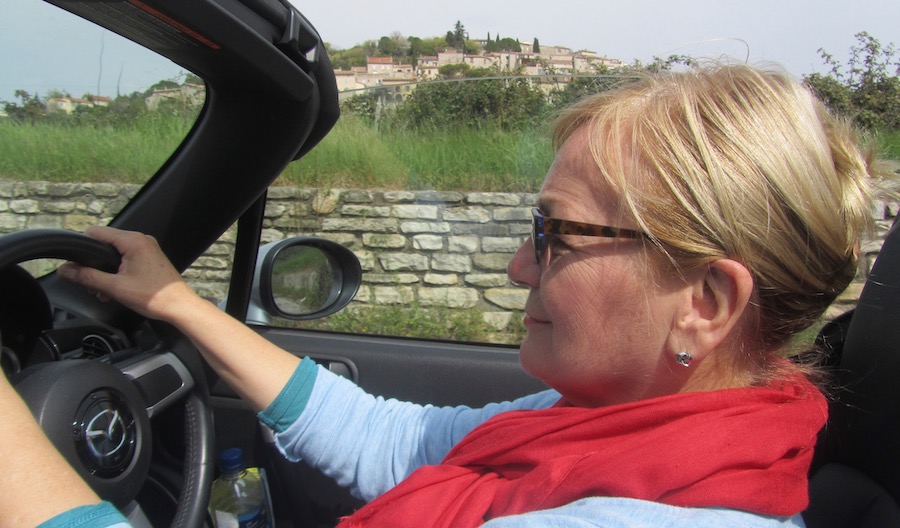
Beijing: Mini-Motorbikes, Packed Buses

NONE of the expats we knew in Beijing had a car, though many had bicycles (it’s a very flat city) or small motorbikes. The newspaper where we worked provided accommodation for expat staff, officially classed as “foreign experts”. There was a high turnover, and as some headed back home they would leave their bikes piled up on the rack outside the apartment block, where they would gather dirt and rust until they were periodically removed by the management. Many of our Chinese colleagues had cars.
Beijing has an ever-expanding subway network and plenty of buses, but public transport is not particularly well planned or easy to use. The subway stations are a long way apart, so when you reach the one nearest to your destination the chances are you’ll still have to walk some distance or catch a bus. But often you’ll get up to the street and find there is no bus stop nearby. The fact that Google Maps is blocked in China and local navigation apps are in Chinese adds to the difficulty many expats find when trying to get around.
Buses on popular routes can be slow moving, and Beijing’s heavy traffic means journeys can take a long time. Sue found them a friendly way of getting around, and learned that just when she thought her bus was full, at least 100 more passengers could pack onto it.
Taxis can be problematic. For instance, you can be told to get out in the middle of a busy, six-lane road because the driver refuses to do a U-turn and drop you off safely outside your destination at the opposite side. Most people use ride-hailing apps, but if you don’t speak Chinese then you’re pretty stuck.
The best solution if you’re heading off to the Great Wall or other tourist attractions is to use a reliable car-and-driver service.
Hong Kong: No Parking, Great Public Transport

IN CONTRAST to Beijing, Hong Kong has fabulous, cheap and reliable public transport, so you don’t need a car. There’s the MTR subway system, loads of buses, characterful double-decker trams, plenty of low-priced taxis, and ferry services to the outlying islands.
We hired a car once for a weekend to explore the New Territories, which let us get around a lot of places in one go, but have never done it again. Unlike many places, Hong Kong is not built for mass car ownership. For one thing, there’s a shortage of parking – a couple of times we went to visit somewhere that weekend, but had to drive on because we couldn’t get parked.
Most of the expats we know in Hong Kong have never driven here, though as in Beijing one or two have small motorcycles. For most, even well-paid finance sector types, car ownership is just not worth the sky-high cost and hassle.
So there you have it. As with all things expat, expect a wide range of car and transport experiences as you move to different countries.
September 2019
Sign up for our FREE newsletter and never miss a post!
Don't Forget Your Driving Licence

IF you’re moving abroad and plan to drive one of the many things you’ll have to sort out is, of course, your driving licence. It’s important to find out what the rules are to avoid problems if the police pull you over. Regulations and practices vary from country to country, and in, for example, China they vary across the different provinces and are subject to change.
In some cases you can drive using a licence issued by your home country for a period of time. In France, for example, you can do this for a year, while in the Seychelles the limit is three months. Generally speaking you should obtain a driving licence in the country where you’re a resident. In many cases expats from some countries will be able to swap their home-country licence for a local one. Those from other countries will probably have to take a test.
We found obtaining a licence in the United Arab Emirates and Hong Kong pretty straightforward. In Saudi Arabia the process was complicated and involved visiting offices in different towns in the desert. Colin had help from our employer’s government affairs office – a department that liaises with officials over a range of matters. Without this support, it would probably have been impossible – which it literally was for Sue. As mentioned above, getting a licence in China can be tricky.
For our fellow Brits planning to move to countries in the European Union, life will become a lot more complicated if and when Brexit goes through. The UK’s Transport Department provides updated details of the requirements for different EU countries on the gov.uk website, but be warned, they’re mind-bogglingly complicated.
RELATED
 TROUBLED TIMES FOR EXPATS: Moving abroad can seem an idyllic prospect, but what happens when sudden upheavals or the inescapable realities of life intrude? READ MORE
TROUBLED TIMES FOR EXPATS: Moving abroad can seem an idyllic prospect, but what happens when sudden upheavals or the inescapable realities of life intrude? READ MORE
 TRIPS HOME: What happens when your home country, the place where you grew up and you know best, turns into somewhere that you go to on holiday? READ MORE
TRIPS HOME: What happens when your home country, the place where you grew up and you know best, turns into somewhere that you go to on holiday? READ MORE
 HOME THOUGHTS: Leaving home to live and work abroad is exciting, but years later you find yourself wondering exactly where is home. READ MORE
HOME THOUGHTS: Leaving home to live and work abroad is exciting, but years later you find yourself wondering exactly where is home. READ MORE
RECOMMENDED
 WELCOME TO OUR WORLD! Afaranwide’s home page – this is where you can find out about our latest posts and other highlights. READ MORE
WELCOME TO OUR WORLD! Afaranwide’s home page – this is where you can find out about our latest posts and other highlights. READ MORE
 TOP 10 VIRTUAL ATTRACTIONS: Many of the world’s most popular tourists sites are closed because of the coronavirus crisis, but you can still visit them virtually while you’re self-isolating. READ MORE
TOP 10 VIRTUAL ATTRACTIONS: Many of the world’s most popular tourists sites are closed because of the coronavirus crisis, but you can still visit them virtually while you’re self-isolating. READ MORE
 SHIMLA, QUEEN OF THE HILLS: Government officials once retreated to Shimla in the foothills of the Himalayas to escape India’s blazing hot summers. Now tourists make the same journey. READ MORE
SHIMLA, QUEEN OF THE HILLS: Government officials once retreated to Shimla in the foothills of the Himalayas to escape India’s blazing hot summers. Now tourists make the same journey. READ MORE
 TEN THINGS WE LEARNED: Our up-to-the-minute guide to creating a website, one step at a time. The costs, the mistakes – it’s what we wish we’d known when we started blogging. READ MORE
TEN THINGS WE LEARNED: Our up-to-the-minute guide to creating a website, one step at a time. The costs, the mistakes – it’s what we wish we’d known when we started blogging. READ MORE
 TROUBLED TIMES FOR EXPATS: Moving abroad can seem an idyllic prospect, but what happens when sudden upheavals or the inescapable realities of life intrude? READ MORE
TROUBLED TIMES FOR EXPATS: Moving abroad can seem an idyllic prospect, but what happens when sudden upheavals or the inescapable realities of life intrude? READ MORE
